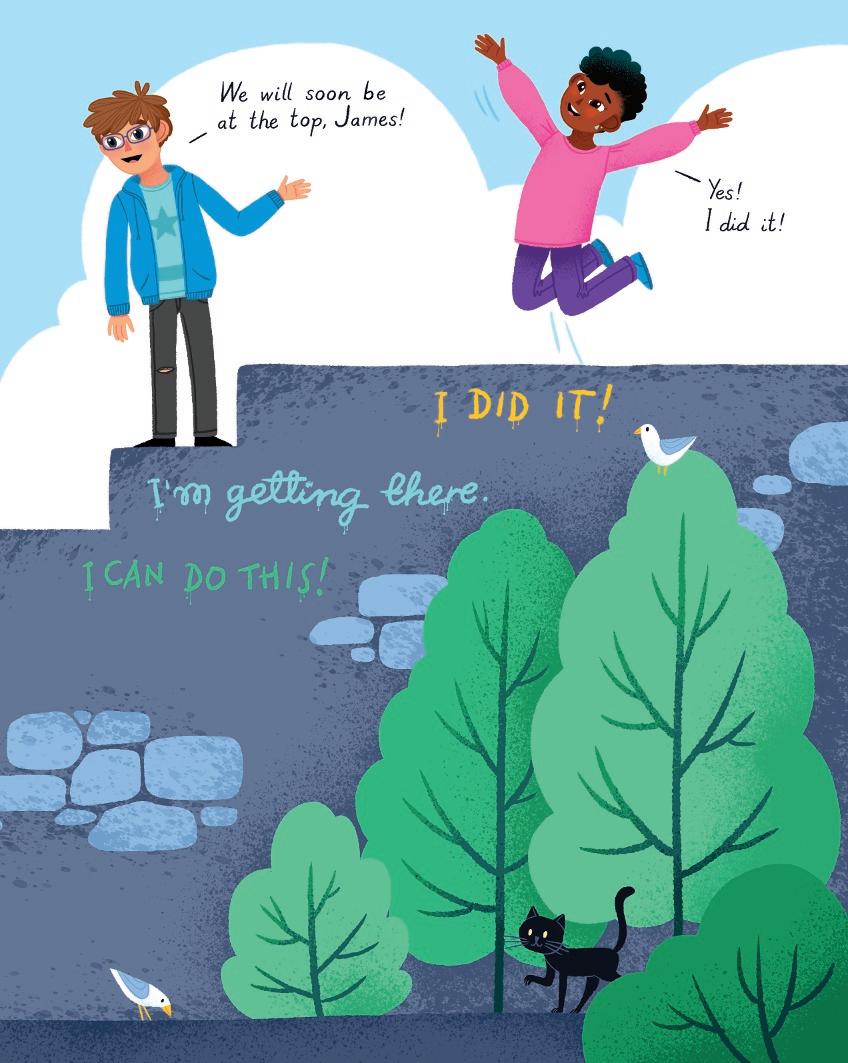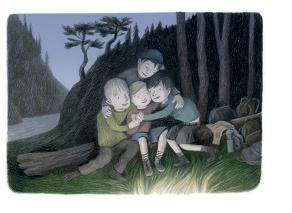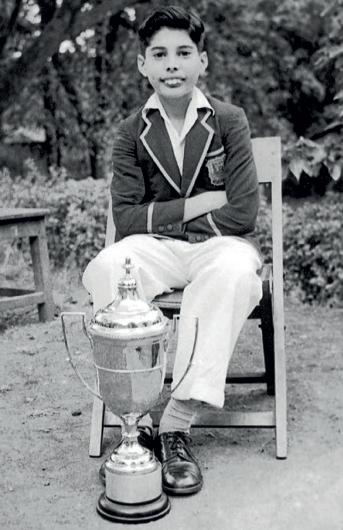Textbook Engelsk for barnetrinnet Bokmål

















Engelsk for barnetrinnet
Bokmål
Copyright © 2022 by Vigmostad & Bjørke AS
All Rights Reserved
1. utgave / 1. opplag 2022
ISBN: 978-82-11-03868-5
Grafisk produksjon: John Grieg, Bergen
Layout og omslagsdesign: Mari Oshaug
Omslagsillustrasjon: Cecilie Ellefsen
Hovedillustratør: Cecilie Ellefsen
Illustrasjoner på s. 12, 28–29, 98, 100–102, 186–189: Akin Duzakin
Illustrasjoner på s. 16–21, 54–57, 82, 90–91: Elisabeth Moseng
Illustrasjoner på s. 66–67, 96, 132–133, 144–147: Rune Markhus
Illustrasjoner på s. 52–53, 137, 198, 200, 206–208, 210–211: Paulina Mingiacchi
Illustrasjon på s. 197: Victoria Sandøy
Forfatterne har mottatt støtte fra Det faglitterære fond.
Spørsmål om denne boken kan rettes til: Fagbokforlaget
Kanalveien 51
5068 Bergen
Tlf.: 55 38 88 00
e-post: fagbokforlaget@fagbokforlaget.no
www.fagbokforlaget.no
Materialet er vernet etter åndsverkloven.
Uten uttrykkelig samtykke er eksemplarfremstilling bare tillatt når det er hjemlet i lov eller avtale med Kopinor.
Språk læres gjennom aktivitet. I link hører, leser og snakker elevene engelsk sammen med de fem gjennomgangsfigurene Jonathan, Mercy, Thea, James og Aryan. I samarbeid bygger de opp begrepsstrukturer og kognitive mønstre fra begynneropplæringen til mellomtrinnet. Med et vell av muntlige og skriftlige aktiviteter samler de kunnskap og øver opp evnen til å lytte, forstå og kommunisere med andre.
Engelskfaget henger sammen med de andre fagene i skolen, med lese- og skriveopplæring i norsk, logisk tenking og utforsking i matematikk. link trekker fram sammenhenger, bygger på det som er kjent, og legger til rette for oversikt og dybdelæring.
link tilbyr digitale verktøy der det gir merverdi, og utnytter til fulle den knappe tiden som engelskfaget har til rådighet.
I link er vi opptatt av interkulturell kompetanse og det å være nysgjerrig på verden rundt oss. Vi øver evnen til å ta ulike perspektiver. Det starter med hver enkelt, med det kjente og nære. I en verden i endring legger vi vekt på det som er felles. Det som knytter oss sammen. Det engelske språket er et nødvendig verktøy, til utforsking, forståelse og samhandling, i fellesskap og medborgerskap.
Velkommen innenfor!
Hilsen forfatterne



I can choose and use a strategy when speaking.

I can find keywords in a text.
I can use a graphic organiser to structure my ideas.
I can reflect on how I express my own identity and cultural background through words, visuals, and performances.
Did you visit anyone this summer? If yes, who, and where?
Mercy: It’s so nice to see you all again. I love summer holidays, but I’ve missed you a lot.

Aryan: I’ve missed you too. It was sad to leave India and my family there, but it’s also good to be back with you guys.
Jonathan: I love the song that you’re playing, Mercy. Which song is that?
Mercy: This is Mercy Myra from Kenya, with Tie Dero. My aunt played this song all the time in Kenya this summer.
Jonathan: Cool! I like it.
Mercy: My cousin’s dog danced to this song. You should have seen it. It was so funny. I wish I had a dog too.
Thea: Can we play “We Will Rock You” by Queen when that song is finished?
Mercy: Why not? I’ll add it to the playlist.
Jonathan: Good idea, Thea! I like that song too.
James: My dad played a catchy song when I was in Canada this summer. Could we play that too?
Mercy: Sure, what’s the song called?
Aryan: No, I don’t want to listen to any of James’s music. He has such bad taste in music.
Jonathan: Haha, I agree with you, Aryan. He listens to the same music as my grandfather.
Thea: Hey, why did you say that, Aryan and Jonathan? That’s rude.
Mercy: I agree, Thea. I think everyone should be able to listen to the music they like without receiving negative comments.
Aryan: You’re right. I’m sorry, James. That was rude.
Thea: What’s the song called, James?
James: “Sweet Home Alabama” by Lynyrd Skynyrd.
Jonathan: Lynyrd Skynyrd? What kind of name is that?
James: The band was named after their gym teacher, Leonard Skinner. He was very strict and wouldn’t let the boys have long hair. My dad told me the whole story this summer.
Aryan: Wow, I’m glad that our teachers don’t make rules about our hair.
Thea: Interesting story. Let’s play the song!
“Sweet home Alabama
Where the skies are so blue
Sweet home Alabama
Lord I’m comin’ home to you”
Jonathan: Wow, that was cool! I’m sorry, James. I won’t mock your taste in music again. Mercy is right. Everyone should listen to the music they like and be open to listening to something new.
• What do you think about Jonathan and Aryan’s comments about James’s taste in music?
• What do you think about how Thea and Mercy stood up for James?
• Do you think schools should make rules about their pupils’ hair and clothing? Why / Why not?
won’t = will not let’s = let us that’s = that is I’ll = I will it’s = it is I’ve = I have what’s = what is don’t = do not you’re = you are I’m = I am wouldn’t = would not
• Did you listen to music this summer? If yes, what kind of music did you listen to?
• What does music mean to you?
• Do you listen mostly to the words or the melody? Why?
• What is your opinion about your parents’ and grandparents’ taste in music?
One day a reporter from the school paper interviewed the pupils in year 6. He wanted to find out more about pupils’ listening habits and the music genres they liked best.
Look at the graph and table. Which kind of music is most popular? Which kind of music is least popular? Make your own questions about the information in
Genre is another word for type. Rock and pop are different music genres.
Mercy: I like pop, like Mercy Myra.
Thea: My favourite is rock! Queen!
Jonathan: I actually like all kinds of music and mixed genres. That’s why I like to listen to the radio.
James: Lynyrd Skynyrd is a new favourite of mine. I love folk rock!
Aryan: Hip hop and rap are genres I like a lot.

Look at the graph. When and where is it most common to listen to music? When and where is it least common to listen to music? Make your own questions about the information in the graph.
Mercy: In the bathroom in the morning.
Thea: When doing my homework (or making art).
Jonathan: When I’m going places, I always bring my headphones and stream my favourite radio stations.
James: When I do my chores or tidy my room.
Aryan: When I need to get rid of some energy!
If you listen to music on your headphones or earbuds, be sure to pay attention to the traffic as well.

• What images come to mind when you hear the word “music”?
• What kind of music do you like? Share it with your learning partner.
• Name other types of music that you know.
• In your opinion, what’s the best time and place to listen to music?
• Make a survey of your own, and ask some of your classmates. Make a chart. Which genre is the most popular?
I wanna walk up the side of a mountain
I wanna walk down the other side of the mountain


I wanna swim in the river and lie in the sun

I wanna try to be nice to everyone
wanna = want to
Read to enjoy!
Can you make movements or a dance to this song?


Did you know that we can turn music into pictures and graphs? There are different ways to visualise (or see) sounds. Here are some of them. Talk to your learning partner about what you see and how you think it might sound.
rhythm (smooth, staccato)
volume (loud, medium, soft)
tempo (fast, moderate, slow)

The life of Frederick Bulsara began on the East African island of Zanzibar on September 5, 1946. He moved to London 25 years later and took the name Freddie Mercury. He joined the rock group Queen. This group became legendary.
Freddie spent most of his childhood in India near Mumbai. He began taking piano lessons at the age of seven. No one could foresee where his love of music would take him. The Bulsara family moved to Middlesex in 1964. Freddie played in several bands, including a blues band. Later he started a band called “Queen”, and the rest is rock history.

In 1973, their debut album Queen was released. It was very successful. Queen became popular outside the UK as their music spread around the world. In 1979 they topped the US charts with Freddie’s song “Crazy Little Thing Called Love”.
Freddie Mercury has been an icon for music lovers ever since.
The main content in this text is…






Look up the keywords you don’t understand.
The difference between… and… is…
The differences between… and… are…
• Summarise the main points of the text together. What is the main content?
• Why is Freddy Mercury called an icon? Explain. Can you give examples of other icons? What is the difference between an icon and a hero?


Read to enjoy!
In 1936, Annie is living in the Hudson Street Orphanage in New York City. It is run by Miss Hannigan, a cruel alcoholic who forces the orphans to clean the building daily.
Clean harder, you filthy kids!
It’s the hardknock life for us.
It’s the hardknock life for us.
’Stead of treated, we get tricked.
’Stead of kisses, we get kicked.
It’s the hardknock life!
My name is Grace Farrell. I work for a very rich man, Mr. Warbucks. He would like to host an orphan child over Christmas.
Grace chooses Annie to live with Mr. Warbucks for Christmas. He lives in a huge manor and has many servants.
Here’s something grand for you to play. Wait!
I couldn’t do that yesterday!
I think I’m gonna like it here. It’s very hard not to, my dear.
Yes! Yes!
I think I’m gonna like it here!
gonna = going to
Who is this? And why is it dancing in my house?
Christmas.
The days go by and they get to know each other better, and Mr. Warbucks starts to like Annie more and more.
My dear Annie. You have melted my heart. I would like to adopt you, to be your father. Would you like that?
Oh! I’d like that very much, but I believe that my real parents are still alive. I want to find them and live with them. Will you help me?
Back at the orphanage.
Mr. Warbucks wants to find Annie’s parents, and give them money so Annie can live a good life.
The little brat!
It ain’t fair this here life
Is drivin’ me nuts!
While we get peanuts
She’s livin’ fat!
Good morning. We are Annie’s parents. We have been looking all over for her.
We are really poor but we love our little Anna… eh… Annie!
Mr. Warbucks, we have found out that Annie’s real parents died many years ago. You have been tricked. We have sent police out to arrest the frauds now.
Annie is back with Mr. Warbucks. This time she wants him to adopt her.
Together at last! Together forever! We’re tying a knot, They never can sever!
I don’t need sunshine now, To turn my skies at blue
I don’t need anything but you!
Joik is a traditional Sámi form of song and is one of Europe’s oldest music forms. Joiking is used to express relationships to people, animals, or nature. Most joiks have few or no lyrics.
Joiks can be performed for entertainment.
In some Sámi areas, people are given their own joik when they are born. It is a great honour to be given a joik. The joik develops with the person and often reflects the personality of the person. Animals and places can also have their own joiks.

In the 1700s, joiking was forbidden because some thought it was sinful and magical. It is not forbidden anymore, but many generations of Sámi people never learned how to joik. In recent years, Sámi artists have often combined joik with other music genres.
Both Elle Márjá Eira and Marja Mortensson combine the joik tradition with genres like pop, electronica, and jazz.
Forbidden

means that something is not allowed.
ISÁK is a music band that combines joik and electropop.

There are many joik dialects: luohti, livde, leudd, vuelie. In Northern Sámi it is called luohti.

Let’s write a song. First, let’s pick a topic. How will we do that?
Read to learn!
A mind map is a good strategy to use to get your ideas going! Take a look at my mind map.

Melody: Hallelujah, Leonard Cohen
Text: Mercy and Thea
I love to hike and sleep in tents, To take in nature’s earthy scents
To paddle my own kayak down the river. To walk upon a mighty hill, To see the view and just be still.
The feeling’s just amazing, you should try it.
Mighty nature, peaceful nature.
Mighty nature, peaceful nature.
Nature comes in many forms; The rainforest has many storms
The forest and the grassland’s good for hiking.
The marshland can be soft and wet.
A desert hike can make you sweat.
The tundra is a treeless Arctic region.
Mighty nature, peaceful nature.
Mighty nature, peaceful nature.
We wrote a song using a mindmap. Look at the rhymes we used. Can you make some rhymes? Try using this melody or find another one, and write a catchy chorus and verses. Good luck!

This song can also be read as a poem.
• Arbeid med interkulturell kompetanse setter engelskfaget i en global sammenheng.
• Engelskspråklige tekster gir bakteppe for nye perspektiver.
• Lese- og skrivestrategier lar elevene jobbe aktivt med innhold.
• Oppgaver med vekt på utforsking utvikler elevenes evne til refleksjon.
• Elevene jobber med kommunikasjon gjennom samhandling og fellesskap.
• Oversikt og dybdelæring gir sammenheng i læresto et.
• Systematisk språklæring gir et godt grunnlag for videre arbeid med faget.
Komponenter på 6. trinn
• link 6 Textbook
• link 6 Workbook
• link 6 Teacher’s Guide
Digitale ressurser for elev og lærer. Alle bøker er tilgjengelige i digital utgave, som d-bok.
Les mer om verket på www.fagbokforlaget.no
ISBN 978-82-11-03868-5
link er et læreverk i engelsk for hele barnetrinnet. Verket er et friskt pust i engelskundervisningen og vektlegger felles, flerfaglige aktiviteter og dybdelæring. I link har vi fokus på interkulturell kompetanse, og vi følger fem gjennomgangsfigurer, fra 1. til 7. klasse. link bygger på oppdaterte læreplaner og tar elevene på alvor i en ny hverdag.